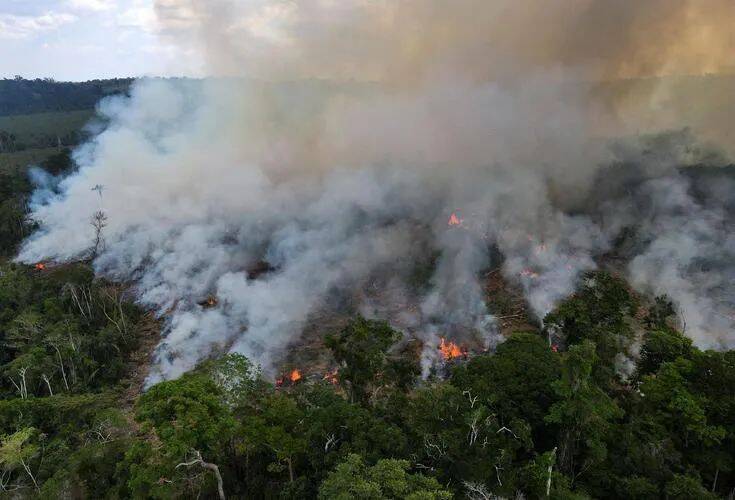Brazil welcomes rain! Coffee production in the new season has eased
According to Brazilian media reports, high temperatures have occurred frequently in Brazil since the beginning of 2024, and the fire is very serious, which has affected many industries. According to the Brazilian ecosystem Map Monitoring Network (MapBiomas) recently released Brazil's national forest fire monitoring report, between January and September 2024, 22.38 million hectares of forest fields in Brazil were destroyed by fires.
The area of forest fields burned in September alone reached 10.65 million hectares, almost the same as in the previous eight months and 150 per cent higher than the 8.98 million hectares in the same period in 2023. Among them, the native vegetation of Brazil affected by the fire accounted for 73% of the burned area, and the proportion of farmland affected by the fire accounted for 20.5%.
According to relevant statistics, during the nine-month period this year, the vegetation areas of Cerrado in Brazil and the Amazon (Amazonas) vegetation cities in Amazon State were the worst hit by the fire this year. Among them, a total of 11.3 million hectares of primary vegetation in the Amazon vegetation area were burned. 8.4 million hectares of land in the Hirado vegetation area were destroyed by fires, which became more frequent and serious during the peak drought in September, with 4.3 million hectares destroyed in September alone. Due to extreme drought, the fire spread rapidly and even affected nearby towns. Earlier, the Brazilian National Federation of Agriculture and Animal Husbandry (CNA) estimated that the fire caused Brazilian agribusinesses to lose at least 14.7 billion reais from June to August.

At present, these conditions have led to higher electricity prices and losses in agricultural production in Brazil, and some Brazilian experts have pointed out that as climate change intensifies, high temperature-related diseases may increase, and outdoor work becomes more difficult. reduced production efficiency and led to more destructive disasters, resulting in casualties and property losses. On the other hand, the aggravation of drought will increase the vulnerability of the ecosystem, reduce the area of available arable land, reduce the production of agricultural products, and reduce industrial productivity, and the impact will be more obvious in the coming months or even years.
In addition these losses have led to higher costs of agricultural production such as the refurbishment of plantations and a reduction in the supply of agricultural products on the market. Electricity prices in Brazil have risen by 5.36% in a month, pushing up the cost of living as a result of insufficient rainfall at Brazil's hydropower stations since September.
However, there is good news that after a long period of hot and dry weather, Brazil will usher in rain in the next few days. But according to Brazil's National Meteorological Institute, rain is likely to fall in most parts of southern Brazil, including the states of Grand Southern, Santa Catarina, Sao Paulo, Goas and Minas.
Although such a large amount of rainfall can effectively alleviate the recent dry weather and help the current fire situation, the rain will not last long and will continue to weaken in the future. In addition, rainfall has reduced the temperature of some porridge in the south and southeast, but the climate in the central part has not changed much, and the climate in Sao Paulo remains around 26 °C.
Despite recent high temperatures and droughts in Brazil, coffee exports remain strong, with Brazil exporting 4.464 million bags (60 kg / bag) in September, an increase of 33.3% over the same period last year, according to the Brazilian Association of exporters (Cecafe). However, there are still logistics implications in terms of exports, with coffee reportedly piling up at the port due to the accumulation of a large number of vessels and containers at the port, which has led to the non-shipment of about 2 million bags of coffee this year, increasing losses for exporting companies.
For these reasons, coffee prices are high in Brazil as well as internationally. In particular, the price of Robusta in Brazil has been higher than that of Arabica in September as production cuts are still reported in the new production season in Vietnam. At present, the spot price of Arabica in Brazil is about 1472.73 reais per bag, and the spot price of Robusta coffee is 1497.46 reais per bag, which is 24.73 reais higher than that of Arabica.
At present, for Brazil's coffee industry, the problems of drought and high temperature continue to affect coffee production in the new production season. Although there is rain, the short-term rainfall has little effect on alleviating the drought, and the high temperature weather still affects the coffee production areas. As a result, coffee production in the new season will not improve much, although the US dollar index rose sharply earlier due to US inflation, driving down commodity prices. The price rate of Brazilian coffee has fallen, but it remains high due to the increase in cost.
For more information about coffee producing areas, please scan the code directly and follow: coffee comments.
Long press the QR code to follow:
Important Notice :
前街咖啡 FrontStreet Coffee has moved to new addredd:
FrontStreet Coffee Address: 315,Donghua East Road,GuangZhou
Tel:020 38364473
- Prev

The highest in history! Best auction of Yemen coffee in 2024 sets record
The Best of Yemen 2024 auction set a new record of US$526.5/LBS (US$1,159/KG), said to be the highest price ever for Yemeni coffee. The highest score at the auction exceeded the high score of 90 points, which was a Yemeni celebrity.
- Next

What are Ethiopian coffee varieties 74158 and 74110?
Friends who often buy coffee beans will definitely pay attention to coffee varieties, because coffee varieties are an important factor in flavor composition in addition to the production area and processing method. In the column of Ethiopian coffee beans, the most common one is "Heirloom". However, in recent times, Ethiopia has begun to appear a series of numbers.
Related
- Is espresso stored overnight in the refrigerator harmful to your body? Is frozen coffee better than freshly ground coffee?
- What parameters and proportions of water temperature should be used to grind and brew fresh coffee beans? Why can't I drink freshly roasted coffee right away?
- Customers have "changed" Manner's new products! Shop assistant: Please don't mess around!
- Remove sockets in customer areas at Starbucks stores?! Netizen: I won't go if I really tear it down
- What is the difference between the taste steps of sun-dried coffee and washed coffee? Why is sun-cured coffee sweeter and washed coffee sour?
- The recipe for salty grapefruit dirty is revealed! Coffee Festival salty grapefruit dirty coffee making materials parameters ratio milk share!
- How about the flavor of Sunlight 74158 at Sidamo Banshaha Mathieu Processing Factory in Ethiopia? 74158 Share the proportion of coffee brewing parameters!
- What effect does Italian American coffee with filter paper have? Will coffee taste better if it is put on filter paper at the bottom of the powder bowl?
- What is the color difference in coffee beans? What are the characteristics of honey processed coffee beans? Why are the anaerobically treated coffee beans uneven in color?
- How does novice Xiaobai quickly get started and make coffee? Newbies learn to make coffee by hand and share the specific steps and process process!

